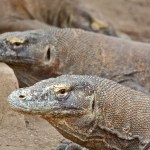lifespan
Photo of a Greenland shark from Wikipedia.
A multi-national team of scientists sought to determine the age of Greenland sharks (Somniosus microcephalus). These animals grow rather slowly (about 1cm per year) and are the largest fish in the arctic (>500 cm long), but their longevity was not yet known. The team used radiocarbon dating of crystalline proteins found within the nuclei of the eye lens. Because these proteins are formed prenatally, they offer a rather accurate way to estimate an animal's age. Their findings, published in Science…
Image of Indonesia's Komodo dragons from Scientific American.
Dr. Tim Jessop from the University of Melbourne, Australia and colleagues spent eight years following 400 Komodo dragons (Varanus komodoensis) to learn more about their growth rate, lifespan as well as differences between populations on isolated Indonesian islands. Their most surprising finding was that female Komodo dragons only live an average of 32 years whereas males live for about 60 years. Females are additionally smaller (1.2 meters long, 22 kg body mass) than males (1.5 meters long, 70…
Although slimmer, calorie restricted rhesus monkeys (left) do not live longer than their age-matched counterparts (right). (Housing shown was for photo purposes only; Image: National Institutes of Aging; Austad SN, Nature 2012).
Despite promising results in mice and rats that calorie restriction prolongs lifespan, results from the US National Institute on Aging (NIA) in Bethesda, MD were just published in Nature last week and concluded that calorie restriction for primates had no effect on longevity.
In the study, young and old rhesus monkeys were fed either control…
Arboreality has allowed for the evolution of increased longevity in mammals:
The evolutionary theory of aging predicts that species will experience delayed senescence and increased longevity when rates of extrinsic mortality are reduced. It has long been recognized that birds and bats are characterized by lower rates of extrinsic mortality and greater longevities than nonvolant endotherms, presumably because flight reduces exposure to terrestrial predators, disease, and environmental hazards. Like flight, arboreality may act to reduce extrinsic mortality, delay senescence, and increase…
An assortment of tree-living mammals
In The Descent of Man, Darwin talked about the benefits of life among the treetops, citing the "power of quickly climbing trees, so as to escape from enemies". Around 140 years later, these benefits have been confirmed by Milena Shattuck and Scott Williams from the University of Illinois.
By looking at 776 species of mammals, they have found that on average, tree-dwellers live longer than their similarly sized land-lubbing counterparts. Animals that spend only part of their time in trees have lifespans that either lie somewhere between the two extremes or…
This is a weird little fact which I've known for a while, but I thought readers might get a kick out of it. What is the longest-lived vertebrate individual which we have records to the extent that we can confirm with a high degree of certitude? You can guess the age and the rough species, but click below the fold for the answer. As hints I will state that the age was in excess of 150 years, and that the individual was not a tortoise.
It was a koi named Hanako who made it to the age of 226 years. Hanako was born in 1751, and died in 1977. (I notice this was posted on Boing Boing, so likely…
It's 1964, and a group of Canadian scientists had sailed across the Pacific to Easter Island in order to study the health of the isolated local population. Working below the gaze of the island's famous statues, they collected a variety of soil samples and other biological material, unaware that one of these would yield an unexpected treasure. It contained a bacterium that secreted a new antibiotic, one that proved to be a potent anti-fungal chemical. The compound was named rapamycin after the traditional name of its island source - Rapa Nui.
Skip forward 35 years and rapamycin has made a…

